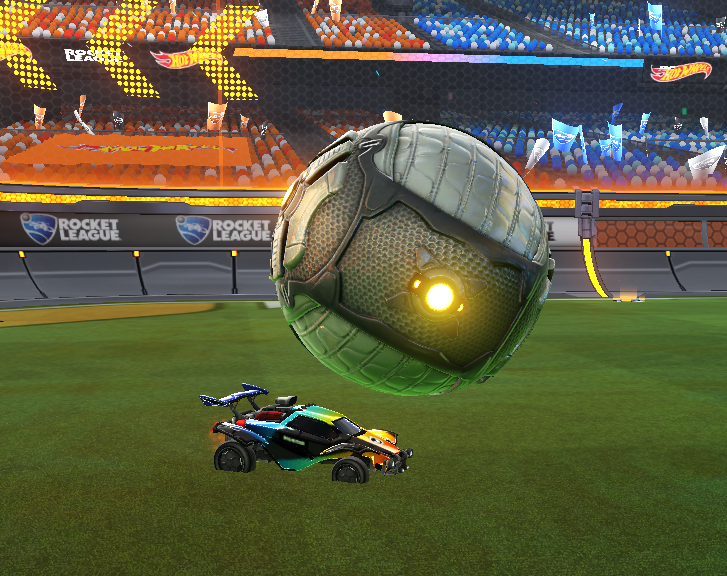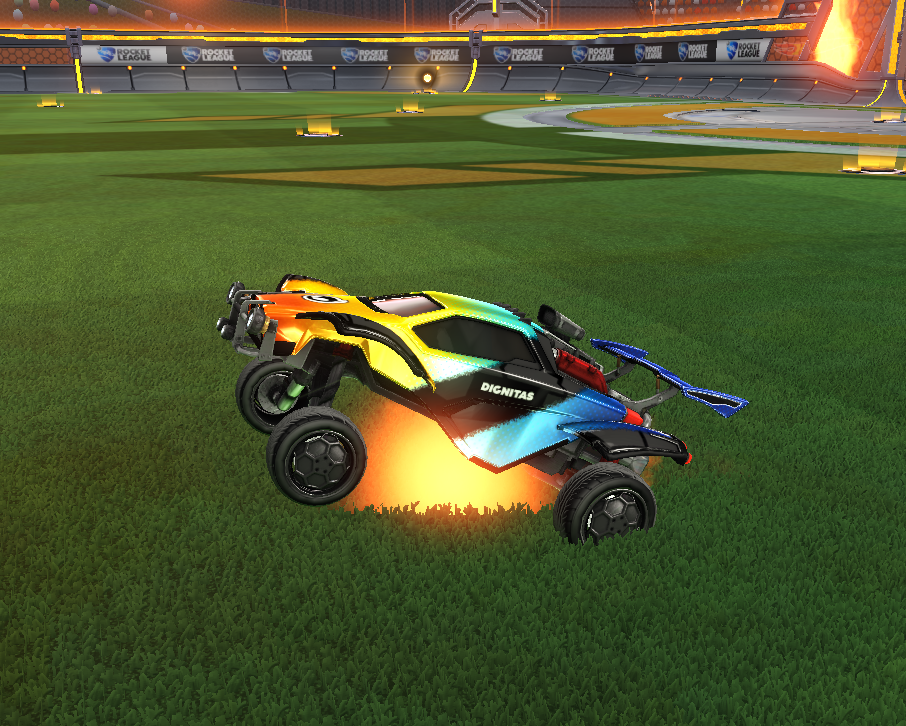Though it’s based on football, Rocket League is a game that tends to take to the air frequently; some of the most memorable moments are aerial, and players strive to utilize difficult aerial mechanics, such as the flip reset, to improve their game. However, with the hype around flashy, aerial mechanics, sometimes players, especially at the lower ranks, neglect their ground game, which can prove to be more effective in many cases. Especially in 1v1 and 2v2, grounded mechanics are essential to ranking up, and today I will show you five grounded mechanics that are staples of any high-level player.
1. The Dribble
Dribbling is a classic mechanic, as old as the game itself, and yet has so much nuance that players tend to overlook. The gist of this mechanic is balancing the ball on the roof of your car, putting you in a position where you have a great degree of control for subsequent actions:

Learning how to dribble is one of the most important things to do, before moving on to any other grounded mechanics; dribbling is a base for many other skills. Training packs are essential for feeling how the ball interacts with your car and developing a sense of intuition with which you can dribble. The setup is just the beginning, however; depending on where the ball is located on your car, you can proceed into a plethora of offensive maneuvers; among these are the ground-to-air dribble, low 50/50, and flicks. Flicks are by far the most potent of these; at a whim, high-level players can propel the ball from a stationary position with such a great degree of force. Expertly positioning the ball on the side of his hood, Frenchman Axel "Mawkzy" Timone unleashes this monster into the top of Jack “ApparentlyJack” Benton’s net:
Due to its versatility, the dribble is one of the most common mechanics to learn, but mastery of it pays dividends. Through an understanding of the nuances of dribble control, you can expertly maneuver the ball to maneuver through the ranks.
2. The Bounce Dribble
Next up is the bounce dribble, a personal favorite of mine. Traditionally, when dribbling, the ball is kept on the hood of your car, in the position for a flick. However, the bounce dribble takes a far different approach from this, instead relying on controlling the ball through light touches, keeping a small bounce with it. Though flicks aren’t achievable with such a setup, the bounce dribble enables powershots that are backed by an immense amount of force, generating a volley on net from the bounce maintained by the ball. This mechanic requires a bit more space than others—you need to be able to bounce the ball without being challenged—and is more effective in modes with fewer players. However, when you can pull it off, a well-placed shot off of a ground dribble is nearly impossible to defend. A professional player who became notorious in the 1v1 scene for his bounce dribble ability was Khalid "oKhaliD" Qasim, a current player for Team Falcons, first seed in the Middle East and North Africa region. oKhaliD was a 1v1 behemoth, using bounce dribbles to consistently surprise his opponents with a burst of power on net. In this clip below, oKhaliD quickly takes control of the ball in a high-level ranked game and uses a short bounce dribble to quickly unleash an unstoppable shot on net:
Even at close range, the bounce dribble can generate immense power. This makes sense, as it essentially just creates a moving opportunity for a power shot, which you can aim as you wish. The power this mechanic holds is immense, and in 1v1 situations, a successful powershot off of a bounce dribble can be unsaveable. Using small, controlled touches, the bounce dribble leads into shots that seemingly come out of nowhere. For a more in-depth look at the bounce dribble, I recommend this video by Ricardo “iRicky01” Obregon, another high-level 1v1 player.
3. The Low 50/50
The third mechanic we’ll be covering is the low 50/50, likely the least-known mechanic on this list. The name pretty much says it all; in this mechanic, you challenge your opponent while taking a low position, which can grant a massive advantage when your opponent jumps for the ball. This mechanic is by far the most useful in 1v1 situations, as it relies on forcing action from your opponents; the goal is to bait your opponent into jumping into the ball through a feint, and then simply lowering the ball to have a far better vantage point.
You can transpose into this mechanic from a dribbling position, dropping the ball from a flick position to directly in front of the nose of your car. It functions as a fake of sorts, fooling your opponent into the wrong response, which will almost always be beneficial to you. However, you should be wary; if you try to use a low 50/50 and your opponent reads it, perhaps if you use it too often, then you may be put in a disadvantageous position. Other than that though, the low 50/50 is a critical tool that you can add to your ground arsenal.
4. The Powerslide and Wavedash
These next mechanics have been grouped together, as they both serve a very similar purpose, but are both very distinct. The first is the powerslide, a pretty basic mechanic that doesn’t get enough love at the lower ranks. Powerslide is one of the most important ways to conserve momentum in Rocket League; it reduces friction, and thus sharper turns are possible without losing a significant amount of speed. Higher ranks tend to use powerslide more often and for shorter durations, as this allows for speed to be optimally conserved; in excess, you lose control, so make sure to be mindful of powersliding. However, using it in moderation is crucial for keeping up rotations, and keeping up grounded speed is essential for strong attacks. Finally, powerslide is indispensable for turning and general maneuvering of your car; powerslide allows for much shorter turn radii, meaning that you can make adjustments to your trajectory very quickly on the ground.

The wavedash is the second of these crucial recovery mechanics; frequently used in tandem with the powerslide, it allows you to generate speed quickly without boost. To perform this mechanic, one jumps from whatever surface they are on, tilts their car slightly backwards, and then flips as their back wheels hit the ground, canceling the flip animation and quickly granting a burst of speed. This proves advantageous due to less time committed to the animation, meaning that you can quickly change your direction after a wavedash, especially in comparison to the long animation and displacement of a traditional flip. This mechanic proves to be even more effective on the walls; when you are moving from the wall to the ground, jumping off and then tilting your car towards the ground to perform a wavedash can give you a significant amount of speed. Some players have even managed to chain wavedashes on the wall together to amass an absurd amount of speed, which is becoming more prevalent in professional gameplay. For a quick tutorial on the “wall-dash”, you can take a look at this video by Mariano “SquishyMuffinz” Arruda.
5. The Speedflip
Finally, we have arguably the most immediately impactful of these mechanics, I would argue, the speedflip. This mechanic has become quite popular recently, be it through YouTubers popularizing it or pros implementing it in their gameplay. In essence, the speedflip is an incredibly fast flip that uses an air roll and a flip cancel to maintain forward boosting throughout the entire flip, allowing for the fastest method of movement currently known in-game. Especially at the higher ranks, this mechanic becomes essential for keeping up with kickoffs; against opponents with suboptimal kickoffs, it may even net you a free goal right off the bat. The mechanic is not as intuitive as the others on this list but is without a doubt just as important. I wholeheartedly recommend this tutorial made by Jack “ApparentlyJack” Benton during his time on Dignitas to learn an effective technique to master this mechanic:
Though it is most notorious for its utility on kickoffs, the speedflip is also indispensable when it comes to recovery and simply getting to the ball as fast as possible. The small speed boost is an incredible asset both on offense and defense, and in a game like Rocket League, it’s crucial to get all the ground speed that you can get. Though the mechanic has received a great deal of recognition, it is crucial to use speedflips in recovery situations as well, supplementing both offense and defense on the ground.
Conclusion
As you have seen throughout the course of this article, there is a plethora of ground mechanics that can supplement your arsenal; though the air is effective, sometimes it serves best to stick to the ground and demolish your opponent. I hope that this article has shown you the offensive, recovery, and defensive utility of all these grounded techniques; thank you for reading, and good luck with your ground game, enriched by this arsenal of techniques!

